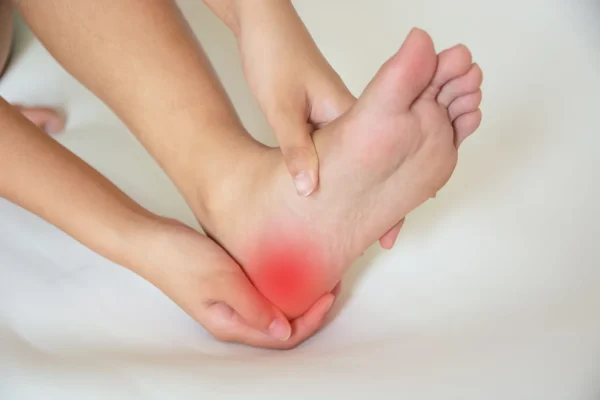Got Heel Pain While Walking? 6 Relief Options
Heel discomfort while walking is a common issue that many people experience. It's not unusual to feel an ache or discomfort in your heel after a long walk or a day spent on your feet. However, just because it's common doesn't mean you have to live with it. With the right approach, you can find relief and continue to enjoy your daily walks, workouts, and activities.
It’s important to find support options that address the discomfort and support your overall wellness. After all, your well-being is the ultimate goal, and finding ways to walk comfortably is a large part of that.
What Can Cause Heel Discomfort?
What causes discomfort for one person might not be the same for another. However, understanding some of the common causes can guide you toward effective relief options.
Overuse or Strain
One of the most common causes of heel discomfort is simply overuse or strain. This can happen when you increase your walking or running distance too quickly or when you spend long periods on your feet without adequate rest. Your heel takes on a lot of pressure during these activities, and without proper care, this can lead to discomfort.
Improper Footwear
The shoes you wear can also significantly contribute to heel discomfort. Shoes that are too tight, too loose, or that lack proper support can put extra stress on your heel — this is especially true if you're walking on hard surfaces or participating in high-impact activities.
Lack of Flexibility
A lack of flexibility in your foot and leg muscles can lead to heel discomfort. Tight calf muscles, for instance, can pull on your heel, causing discomfort during walking. Regular stretching can help maintain flexibility and prevent discomfort.
What Are 6 Relief Options for Heel Discomfort While Walking?
When it comes to finding support for heel discomfort, there's no one-size-fits-all solution. Different strategies work for different people, and sometimes, it's a combination of approaches that provides the most comfort.
Let's explore some options that can make a big difference in your comfort level while walking.
1. Proper Footwear
First off, let's talk shoes. The right footwear can be life-changing when dealing with heel discomfort. Shoes that provide the right support can help distribute pressure evenly across your foot, reducing the strain on your heel. They can also cushion your steps, making each stride more comfortable.
When choosing shoes for walking, look for options that have good arch support and a slightly elevated heel. The arch support can help distribute your body weight evenly, while the elevated heel can reduce pressure on your heel.
Also, consider the fit of your shoes. They should be snug but not too tight, with enough room for your toes to move freely. Lastly, note that even the best shoes wear out over time. If your favorite pair of walking shoes is old and worn, it might be time for a replacement.
2. Stretching and Strengthening Exercises
Another key element in managing heel discomfort is regular stretching and strengthening exercises. These exercises can help improve flexibility, strengthen the muscles that support your heel, and promote overall foot health.
One simple yet effective exercise is the calf stretch. Stand at arm's length from a wall, place your hands on the wall, and step one foot back, keeping it flat on the floor. Bend your front knee and keep your back knee straight. You should feel a stretch in your back leg's calf muscle. Hold for 30 seconds, then switch sides.
Another helpful exercise is the towel stretch. Sit on the floor with your legs straight out in front of you. Loop a towel around the ball of one foot, then gently pull back on the towel, keeping your leg straight. You should feel a stretch along the bottom of your foot and up the back of your leg. Hold for 30 seconds, then switch sides.
Strengthening exercises like heel raises, where you stand on your toes and then slowly lower your heels, can help strengthen the muscles that support your heel, making them more resilient to strain.
3. Rest and Relaxation
When it comes to addressing heel discomfort, never underestimate the power of rest and relaxation. Your body does its best healing work when it's at rest, and that includes your feet. If you're experiencing heel discomfort, taking breaks from prolonged standing or walking, especially on hard surfaces, can be a big help.
Think of it this way: Just like you need to recharge after a long day, so do your feet. Giving them a break can help reduce discomfort and prevent further strain. This could mean sitting down for a few minutes every hour if you're on your feet all day or alternating standing with sitting tasks if possible.
4. Cold Therapy
Another simple yet effective relief option is cold therapy. Applying a cold pack to your heel can help soothe discomfort and reduce any excessive warmth you might be feeling. Cold therapy works by constricting blood vessels, which can help to minimize discomfort and promote comfort.
Always wrap your cold pack in a towel before applying it to your skin to avoid frostbite. Also, it's best to limit each cold therapy session to 20 minutes at a time, with at least an hour break in between.
5. Managing Stress Levels
Chronic stress can manifest in physical ways, including causing discomfort in the body, such as in the foot and heel. That's why managing your stress levels can be an integral part of finding relief for heel discomfort.
Mindfulness and meditation are two techniques that can help your body maintain healthy stress levels. These practices encourage you to focus on the present moment, which can help calm your mind and relax your body. Even just a few minutes a day can make a difference.
Everyone's journey to comfort is unique. What works for one person may not work for another. So, don't be discouraged if you need to try a few different strategies before finding what works best for you. The important thing is to listen to your body and take steps towards comfort and wellness.
6. Try CBD for General Discomfort
CBD can be incredibly useful when it comes to supporting balance and soothing feelings of tension and discomfort. The body’s endocannabinoid system (ECS), which CBD interacts with, works to maintain balance in many bodily functions. The ECS includes cannabinoid receptors that are found throughout the body, including the feet.
In addition to consumable products like CBD gummies and cannabidiol drops that can help encourage healthy stress levels and sleep patterns, topical CBD products like our CBD recovery balms can be applied directly to the source of discomfort, such as the heels, for localized, targeted relief. This targeted approach allows you to address discomfort exactly where you need it when you need it.
When To Seek Professional Help
While these tips can help manage mild to moderate heel discomfort, it's essential to remember that persistent discomfort should not be ignored. If you've tried various relief options and your discomfort persists or worsens, it may be time to seek professional help.
A health professional can provide guidance tailored to your specific needs and help ensure you're on the right path to maintaining your overall wellness.
The Bottom Line
Heel discomfort while walking can be a challenge, but with the right strategies, you can find relief and get back to enjoying your daily activities. Whether it's choosing the right footwear, practicing regular stretches, or trying out CBD, the important thing is to find what works best for you. Your comfort and wellness are worth it!
At Muscle MX, we’re here to support you on your wellness journey. We offer a range of all-natural CBD products designed to help support comfort and wellness, helping you to step into a more comfortable, balanced, and enjoyable life.
Sources:
Impact of routine footwear on foot health: A study on plantar fasciitis | PMC
Plantar fasciitis stretches: 6 exercises for heel pain relief | Medical News Today
Cold Therapy (Cryotherapy) for Pain Management - Health Encyclopedia | University of Rochester Medical Center
Stress effects on the body | American Psychology Association
The endocannabinoid system: Essential and mysterious | Harvard Health










































